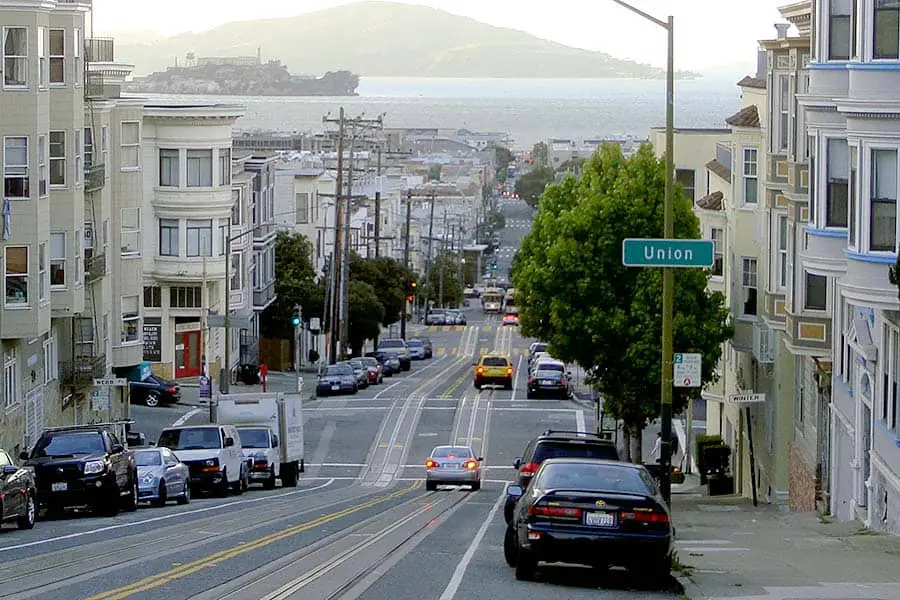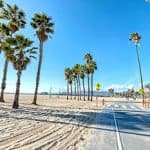
San Francisco is a notoriously hilly city. Whether it’s the unbelievable zig-zag of Lombard Street or the wildly steep 31.5% grade of 22nd Street and Filbert Street, we know the Golden City to be a wild series of slopes caroming into one another at various places throughout the city. But while we know it is a hilly city, is San Francisco really in the mountains?
There are numerous mountains within a short distance of San Francisco. So, it’s correct to say San Francisco is near the mountains, but not in the mountains. The highest peak in San Francisco is Mt. Davidson, at 938 feet above sea level, and the mean altitude of the city is merely 52 feet above sea level.
So what mountains can you access from San Francisco? What about the city’s well-known hills and the surrounding landscape? What kind of famous ridges, mountains, or other geological landmarks are in or around San Francisco? I’ll answer these questions in the following paragraphs.
San Francisco: Mountains and Molehills

San Francisco is a maritime city situated on a bay. While it may be known for its proximity to the ocean, the Golden City is also known as a city of hills and slopes. One of the more popular tourist stops in the city is Lombard Street, whose famed switchbacks carve a neighborhood out of a steep hillside. The Bay Area, more generally, is known as being a very hilly place. As it happens, the San Francisco peninsula is part of the Santa Cruz mountain range.
The Santa Cruz Mountains span coastal California, separating the Pacific Ocean from the San Francisco Bay. The northern terminus of the Santa Cruz Mountains is Montara Mountain, located about 30 miles south of the city.
The Santa Cruz Mountains form a long southbound ridge, with a southern terminus in the Salinas Valley. Motorists can even drive along the ridge by picking up Sloat Boulevard in San Francisco and heading south until they reach SR35, Skyline Boulevard, which rides along the spine of this mountain ridge.
Running almost parallel to the Santa Cruz Mountains is the Diablo Range. Beginning at Mt. Diablo, the range runs south and terminates at the Salinas Valley. Because it is protected from moisture and certain meteorological phenomena by the Santa Cruz range to the west, the Diablo Range is dryer and milder.
The rolling hills of San Francisco are part of the foothills of Montara Mountain. The city and the mountain both come from the same basic geological activities. Thousands of years ago, the Pacific Plate and the North American plates collided and ground together.

Eventually, the Pacific plate was subducted beneath the North American Plate, creating the region’s unique geology, including notorious features such as the San Andreas Fault.
Mountains are also found to the north of San Francisco. While Montara and the Santa Cruz Mountains lay south of the city, Mt. Tamalpais and the Marin Hills are situated just across the Golden Gate.
Mt. Tamalpais and the Marin Hills are considered part of the northern California Coastal Range and are not part of the Santa Cruz Mountains that border San Francisco’s south. Geologically, the Marin Hills are more closely related to the Klamath Mountains than to the Santa Cruz Mountains.
That said, all of these mountain groups and chains belong to the more extensive Pacific Mountain System, which stretches all the way from Alaska to Mexico. No matter what mountain you go to near San Francisco, you can impress your friends by telling them it’s part of the Pacific Mountain System – you won’t be wrong. San Francisco may not be situated on a mountain per se, but it seems like you can’t throw a rock without hitting a mountain range in the Golden City.
Perhaps more notorious than the mountains around the city are the seven hills of San Francisco. Indeed, when one thinks of the City by the Bay, one thinks of hills dotted with Victorian homes, Lombard Street, sweeping and steep city panoramas. The hills are part of the identity of the city.
Bay Area Answers Fun Fact: The original City of Seven Hills was Rome. Ever since the resounding historical success of this early city, municipalities around the world have copied Rome’s designation as a City of Seven Hills – San Francisco among them.
While San Francisco is home to far more than seven hills, the seven most famous hills in the city are:
- Rincon Hill – 100 feet
- Telegraph Hill – 284 feet
- Russian Hill – 294 feet
- Nob Hill – 376 feet
- Lone Mountain – 448 feet
- Twin Peaks – 904 feet
- Mount Davidson – 925 feet
Why is San Francisco so Hilly?
So we know that San Francisco is very hilly, but why? The answer lies back in geological time, in an epoch long past. Thousands of years ago, tectonic plates crashed into one another in the region now known as the Bay Area.
As these plates crushed together, the unimaginable forces involved in this tectonic collision crumpled parts of the plates into the hills, valleys, and mountains that define the region’s topography. In the future, the plates, faults, and forces underlying North America and San Francisco will likely have been sculpted into new shapes by geological forces.
Other Posts of Interest
- Does San Francisco Have Seals Or Sea Lions?
- What Are The Painted Ladies In San Francisco?
- Is San Francisco In Silicon Valley?
- Is South San Francisco Part Of San Francisco?
Is All of San Francisco Hilly?
San Francisco has some neighborhoods and areas that are flat. As a maritime city, San Francisco has expansive sea-level frontage. Many neighborhoods, such as the Mission District, Noe Valley, the Embarcadero, and South Beach, are very flat. Many touristy areas such as Fisherman’s Wharf, Ghirardelli Square, and the Marina District are also relatively level and not at all hilly. San Francisco is undoubtedly a city of hills, but there’s plenty of flat land too.
What is the Elevation of San Francisco?
San Francisco covers a lot of terrain, and that terrain varies in altitude. The city boasts locations at sea level and as high up as 925 feet or so at Mount Davidson. How can we say what elevation the city is when points in the city have such a wide range of elevations? With sophisticated tools, we can take an average. Computer scientists with topographical maps and complex mathematics have calculated the mean elevation of San Francisco, which is about 92 feet above sea level.
Are San Francisco’s Hills Steep?

Yes, many of San Francisco’s hills are pretty steep. Some sections of road have grades exceeding 30%, which means for every 10 feet forward, you go 3 feet up. Romolo Street has one section with a 37.5% grade – steeper than the takeoff path of a departing jumbo jet. The Russian Hill neighborhood has plenty of steep hills and also happens to have some excellent city views.
What Peaks Can You Visit Near San Francisco?
If reading about the hills and mountains has inspired you to go climb, you’re in luck: many peaks are within a short distance of the Golden City. Those looking for a good hike should head to Mt. Tamalpais State Park, a short drive north from the city. There, a 13.3-mile loop trail will take you to the peak and back down again. This trail is a challenging hike, so newbies or those not prepared for some serious hiking might want to consider a less difficult path at the park.
Are you looking to drive to a peak? Mount Diablo offers visitors the chance to simply drive your car to the visitor’s center and appreciate one of the finest views in California. And for those who like the beach, Montara State Beach encompasses Mount Montara.
How Do the Mountains Affect the Local Climate?
The topography of the greater Bay Area has a direct impact on San Francisco’s weather. The mountains and valleys that define this region of California create little microclimates, many of which generate specific local conditions that have led to interesting ecological niches. For example, the San Francisco Peninsula’s unique weather patterns have led to a wide diversity in the plant kingdom. The mountains and valleys affect rain, cloud, and fog patterns which in turn affect local flora, fauna, and even people.
If the mountain ranges didn’t follow the coast as they do, the weather in San Francisco would be completely different:
- The traditional cool summers would be warmer.
- The fog would probably be less severe.
- Rainfall patterns would be very different.
The presence of the mountains definitely affects San Francisco’s climate.
The Hills are Alive
The Bay Area is known for mountainous, rugged terrain that offers beautiful hiking and some of the best outdoor activities in the United States. Despite not being in the mountains, San Francisco provides residents and visitors the opportunity to enjoy the amenities of a world-class city while being only a short trip away from the wonders of nature and some spectacular mountains.
Whether you’re walking up Russian Hill, driving up Mt. Diablo, or hiking through the rugged woods of Mt. Tamalpais, San Francisco’s bounty of hills and nearby mountains leaves you with plenty to explore.





